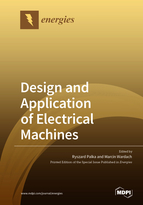Design and Application of Electrical Machines
A special issue of Energies (ISSN 1996-1073). This special issue belongs to the section "E: Electric Vehicles".
Deadline for manuscript submissions: closed (25 August 2021) | Viewed by 43495
Special Issue Editors
Interests: electrical machines; numerical field calculations; optimization of electromagnetic fields; high temperature superconductivity: superconducting machines; superconducting bearings
Special Issues, Collections and Topics in MDPI journals
Interests: electrical machines; numerical field calculations; optimization of electromagnetic fields; renewable energy technologies; electrical engineering; power generation
Special Issues, Collections and Topics in MDPI journals
Special Issue Information
Dear Colleagues,
The Guest Editors are inviting you to submit papers to a Special Issue of Energies on the subject of “Design and Application of Electrical Machines”.
There is little need to prove the importance of the subject matter. Electrical machines are the most important components of both the industrial and the commercial world. They are at the heart of the new industrial revolution brought forth by the development of electromobility and renewable energy systems. Today’s electric motors must meet the most stringent requirements of reliability, availability, and high efficiency in order to match (and exceed!) the useful lifetime of power electronics in the complex system application and to compete in the market under ever-increasing pressure to deliver the highest performance criteria.
Today, thanks to the application of highly efficient numerical algorithms running on high-performance computers, it is possible to design electric machines and entire drive systems faster and at a lower cost. At the same time, progress in the field of material science and technology enables the development of ever more complex motor designs and topologies.
Therefore, the purpose of this Special Issue is to contribute to the development of electric machines. We encourage scientists and application engineers to present the results of their research in the field of design and application of electric machines from the smallest ones with powers up to several watts, to the largest—at megawatt power. We are pleased to accept original research as well as review articles.
Topics of interest for publication include but are not limited to:
- Simulation tools, modeling, and analysis of electrical machines;
- New design methods of electrical machines;
- Optimization of electrical machines;
- Electrical machines for EVs and HEVs;
- Power electronics used for electrical machines;
- Supply and control of electrical machines;
- New technologies, materials, devices, and systems for electrical machines;
- Linear drives for transportation.
Prof. Dr. Ryszard Palka
Dr. Marcin Wardach
Guest Editors
Manuscript Submission Information
Manuscripts should be submitted online at www.mdpi.com by registering and logging in to this website. Once you are registered, click here to go to the submission form. Manuscripts can be submitted until the deadline. All submissions that pass pre-check are peer-reviewed. Accepted papers will be published continuously in the journal (as soon as accepted) and will be listed together on the special issue website. Research articles, review articles as well as short communications are invited. For planned papers, a title and short abstract (about 100 words) can be sent to the Editorial Office for announcement on this website.
Submitted manuscripts should not have been published previously, nor be under consideration for publication elsewhere (except conference proceedings papers). All manuscripts are thoroughly refereed through a single-blind peer-review process. A guide for authors and other relevant information for submission of manuscripts is available on the Instructions for Authors page. Energies is an international peer-reviewed open access semimonthly journal published by MDPI.
Please visit the Instructions for Authors page before submitting a manuscript. The Article Processing Charge (APC) for publication in this open access journal is 2600 CHF (Swiss Francs). Submitted papers should be well formatted and use good English. Authors may use MDPI's English editing service prior to publication or during author revisions.
Keywords
- electrical machines
- numerical field calculations
- optimization of electromagnetic fields
- electrical vehicles
- permanent magnet machines
- hybrid excited machines
- wind power energy







